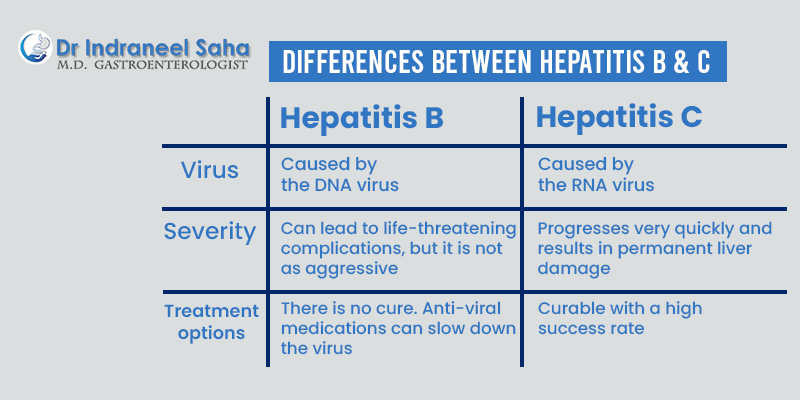- 27th Nov, 2024
- Gastroenterologist
Understanding Hepatitis B And C: Key Differences And Similarities
Hepatitis is often regarded as a silent killer as millions of people continue to live with this condition without any obvious signs or symptoms for years. This condition mainly affects the liver, causing inflammation and if left untreated, eventually progresses to permanent liver damage. There are mainly five common types of hepatitis – A,B, C, D, E.
Hepatitis damages the liver and reduces its ability to flush out toxins. When it comes to hepatitis B and C, people often get confused between these two because they share common routes of transmission and remain asymptomatic for a long time.
However, there are significant differences between hepatitis B and C in terms of their severity, long-term consequences and treatment options. In this blog, we will compare both these conditions to clear misconceptions and provide insights into managing them.
Why Do People Get Confused Between Hepatitis B And C?
One of the primary reasons that make hepatitis B and C confusing is that they both lead to inflammation in the liver and remain asymptomatic for years, i.e., patients are not even aware of the complications in the liver unless they experience serious complications.
Moreover, both are blood-borne pathogens. This shared transmission of the infections means that there is a high possibility that it mostly affects similar groups of individuals.
So, let’s get into details and know the similarities and differences to better understand the conditions.
Key Similarities Between Hepatitis B And C
Dr. Indranneel Saha, a reputed gastroenterologist in Kolkata, lists the points that make hepatitis B and C alike.
- Liver damage: As mentioned already, both hepatitis B and C are caused by viruses, which are responsible for inflammation of the liver, impairing its ability to detoxify and produce essential proteins. If not addressed at the right time, it continues to progress and cause more serious complications like cirrhosis and cancer.
- Transmission: Both get transmitted through blood and bodily fluids. For instance, individuals with unprotected sexual contact, sharing of needles, unsafe blood transfusion, infected equipment, or organ transplantation have a high chance of getting infected with hepatitis B and C.
- Risks: Both affect the liver and put the individuals at a greater risk of developing chronic conditions, which often lead to death.
Differences Between Hepatitis B And C
Below are the things that make hepatitis B and C differ from each other.
- Virus: One of the significant factors that differentiate between these conditions is the type of virus. Hepatitis B is caused by the DNA virus, whereas hepatitis C is caused by the RNA virus.
- Severity: It is true that hepatitis B can cause life-threatening complications, but it is not as aggressive as hepatitis C. On the other hand, the latter condition progresses very quickly and results in permanent liver damage at a higher rate over time.
- Treatment options: There is no cure for hepatitis B. However, there are anti-viral medications that slow down the virus from reproducing and reduce the inflammation of the liver. With the revolution of modern medicines, hepatitis C is now curable with a success rate of more than 90%, approx. Can lead to life-threatening complications, but it is not as aggressive. progresses very quickly and results in permanent liver damage there is no cure. Anti-viral medications can slow down the virus curable with a high success rate.

Conclusion
If you are experiencing symptoms such as jaundice, loss of appetite, fever, fatigue, dark urine and abdominal pain, it is time to consult a top gastroenterologist in Kolkata. He will perform some tests and guide you through the treatment process. Early screening and diagnosis are important to find out the exact condition and prevent fatal complications.